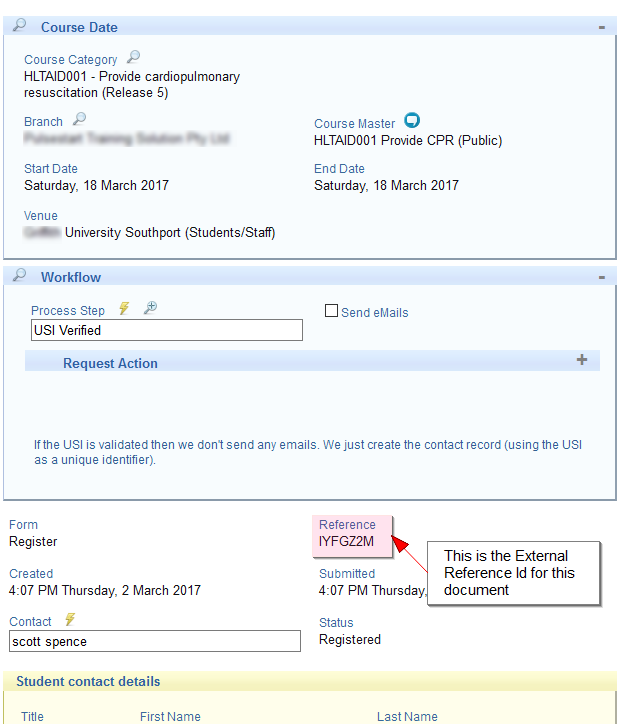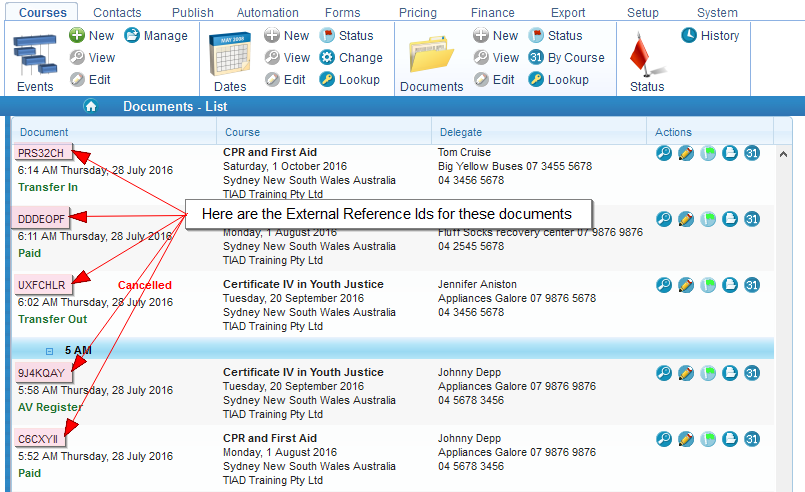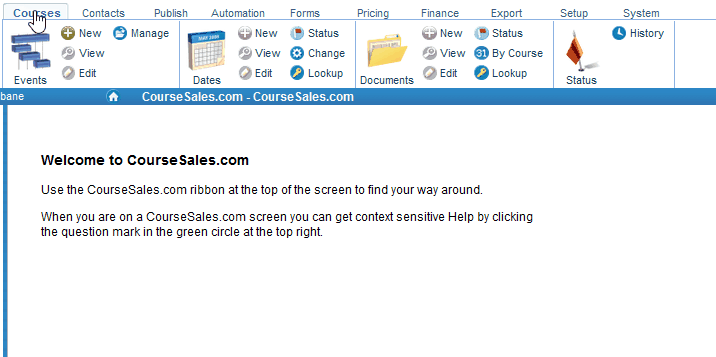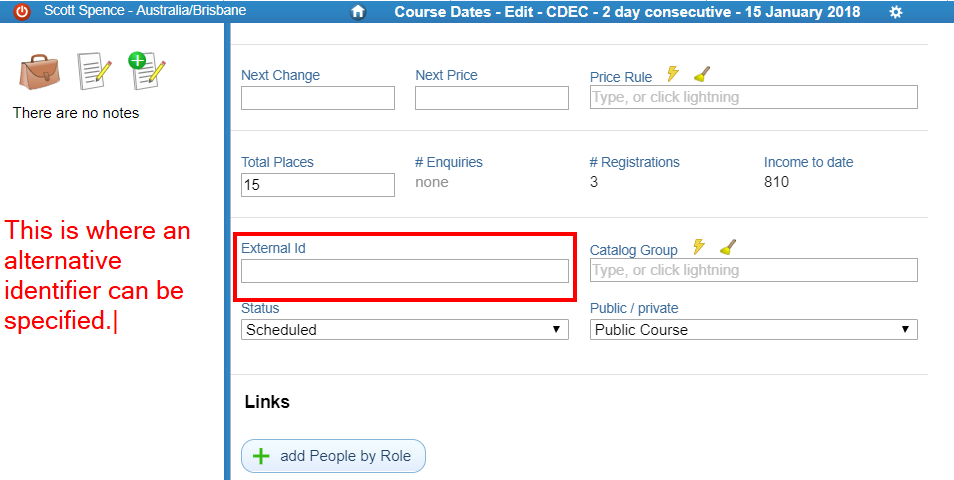Document and contact identifiers are useful when needing to:
-
Provide a link to submit more information or updated information, eg gathering USI data or additional information in a multi-step registration process.
-
Reference a particular registration/booking for customer service or compliance requirements.
When needing to identify documents - aka bookings enrolments or registrations, and contacts aka student clients customers, identifiers can be used for a variety of ways including identifying certificates, referencing invoices, validating achievements (certificates or statements of attainment) and gaining access to the student portal or other third party systems. CourseSales.com has the following identifiers:
Document External Reference Id
Uniquely identifies a document, it is allocated by CourseSales.com - no external reference will be the same even between licenses.
Document Internal reference id
Uniquely identifies a document, it is allocated by CourseSales.com, it is an incremental number - no internal reference id will be the same even between licenses.
Unique Student Identifier (USI)
Allocated by the Australian government to identify each individual who attends vocational training. It is part of the AVETMISS standard and can optionally be included on document forms.
AVETMISS Client Identifier
Allocated by the training company to uniquely identify a student, perhaps from an external or legacy system with the intention to use for AVETMISS exports.
Internal Contact id
Uniquely identifies a contact, it is allocated by CourseSales.com, it is an incremental number and unique for that license only.
Default Contact Id
Uniquely identifies a contact if configured to do so, it is allocated by the configuration of CourseSales.com, options are: Use blank, Use customer email, Assign the next sequential number, Use AVETMISS Client Id, Use Document Source Identifier, Use AVETMISS Unique Student Identifier.
Document Source Id
Uniquely identifies a document within another system, eg Moodle LMS, it is allocated by the external system, and inputted during a synchronization. This is relevant only when documents are coming FROM the external system, not when the documents are generated by CourseSales.com
Moodle User Id
Uniquely identifies a user within Moodle, it is allocated by Moodle, and can be copied across from Moodle (using the Moodle plugins) to the document, then to the contact record as a form of tracking Moodle users.
Document External Reference Identifier
A unique reference number is issued to all documents. this has the format of 7 alphanumeric characters eg: 5AZEXT7. It is recommended that this reference number is included in all emails and PDFs that are sent to customers. It is also recommended that certificates use this reference id to assist in validating a registration. You can also use this reference id to link to a form so that a student can complete a registration.
Where can you find the Document External Reference Identifier?
When a student make a registration the Document External Reference Id is displayed on the Thank You screen. It is also found when editing the document (see below), and displayed in the Document list (see below).


Using the Document External Reference Identifier in links
It is possible to link directly to a document that exists by using this Document External Identifier:
https://{shortname}.coursesales.com/public/form?ProcessStepID={StepId}&DocumentExternalId=[Documents:DocumentExternalId]&h=1
This means that following this link will display the document using the form and actions as specified by the ProcessStepID and associated rules. This can be used to take a student to the next step in a registration process, eg to completed AVETMISS data, or to request a reset on the portal password.
It is also possible to link directly into Wordpress using the Document External Identifier:
http://tiad.coursesales.net/index.php/formsuccess/?DocumentExternalId=HC...
This will take the student directly to the payment page for their course using the payment method specified on the document. Note that this assumes the page where the form-success slug is located is called “formsuccess”.
Using the Document External Id in Certificates
As the Document External Id links to a specific enrolment, or document it can be used on certificates as a reference for those wishing to confirm that a competency or certificate has been issued to that individual, ie the contact. This may be sufficient for authorities to validate certification awards. To increate security of the PDF certificate issued see digital signing of certificates.
Lookup using the Document External Id
If you include this Id on all emails and PDFs, eg certificates and invoices, you can then quickly and efficiently get straight to the document by using the document lookup (note there is also a course date lookup).

Document Internal reference id
Using Internal reference id on invoices
Where the Document External Id is not sufficient, often an incremental number is, eg as an invoice reference. While it is numerical and incremental the Internal reference id is not sequential, ie the numbers may skip as documents are created on other licenses. This number can then be used within your accounting package to reference back to the document within CourseSales.com.
Internal Contact id
AVETMISS reporting
NCVER AVETMISS exports expect a Client identifier to uniquely identify students between the NAT files. If an AVETMISS Client Identifier field is present on the Contact form, and has a valid value it will be used to reference the student. If however it is not on the Contact form then the Contact Id will be exported as the AVETMISS Client Id, and appear on AVETMISS NAT Files. Unless you wish to allocate Client Identifiers manually we recommend that the AVETMISS Client Identifier is not listed on the contact nor document, allowing CourseSales.com to use the internal Contact Identifier. When deciding on an AVETMISS Client identifier keep in mind that it needs to be a maximum of 10 characters, meaning that Moodle usernames and email addresses include the risk of duplication as they will be truncated to 10 characters.
Default Contact Id
Using the Default Contact Id as a Username for the student portal or Moodle
By specifying which of the options outlined in the Default Contact Id will be applied the username for those using the portal or Moodle is also decided. If the Unique Student Identifier is chosen to be the Default Contact Identifier then students will need to enter this when they wish to use the portal. This identifier must exist on the Contact, so if a student has a contact record with a password, they have access to Moodle and the Student Portal.
Document Source Id
The document source id is used when linking to external systems like Moodle, or when importing document topics to existing documents. You can edit a specific document using the document source id by creating a link that matches the following:
https://{shortname}.coursesales.com/document/indexraw?DocumentSourceId=S14-295UEENEEM041E7
Course Date Identifiers
Course Date references can be used for the following purposes:
-
Referencing a Course Date specifically
-
Providing a link to submit a Document (make a booking) on a specific course
-
Linking between another system and CourseSales.com, ie using an identifier from an existing website cart system or calendar system to then link directly to a registration form in CourseSales.com.
Course Date Internal Id
Use the following code if you wish to reference the Course Date Internal Id in an email or PDF: [CourseDates:CourseDateId]
See more Variable short codes for Course Dates
The following is a link to the customer so that they can complete a document on an existing course (public as well as private):
https://{short name}.coursesales.com/public/form?CourseDateId=[CourseDates:CourseDateId]&ProcessStepID={process id}&h=1
-
{short name} is found at the beginning of your xxx.coursesales.com domain name ie xxx.
-
{process id} is which process step that is the request to complete the form you can get the Process ID in two ways, either by using the information cog or by looking at the URL when editing the process step
This will require manually updating the other application to ensure the Identifiers are consistent. between the two systems.To link to a course within another software application you can manually copy the Course Date Internal Id into the software system, then, creating an email with the link above use this to general automatic emails that include the process id and the Course Date Internal Id into the link as required to ensure the customer is directed to book on the appropriate course.
Course Date External Id
Use the following code if you wish to reference the Course Date External Id in an email or PDF: [CourseDates:CourseDateExternalId] see more course date short codes here

The following is a link to the customer so that they can complete a document on an existing course (public as well as private):
https://{short name}.coursesales.com/public/form?CourseDateExternalId=[CourseDates:CourseDateExternalId]&ProcessStepID={process id}&h=1
-
{short name} is found at the beginning of your xxx.coursesales.com domain name ie xxx.
-
{process id} is which process step that is the request to complete the form you can get the Process ID in two ways, either by using the information cog or by looking at the URL when editing the process step
This will require manually updating CourseSales.com to ensure the Identifiers are consistent. between the two systems.To link to a course within a CourseSales.com email you can manually copy the other software Identifier =into each Course Date’s ‘External Id’ field. Then creating an email with the link above use this to general automatic emails that include the process id and the Course Date External Id into the link as required to ensure the customer is directed to book on the appropriate course.